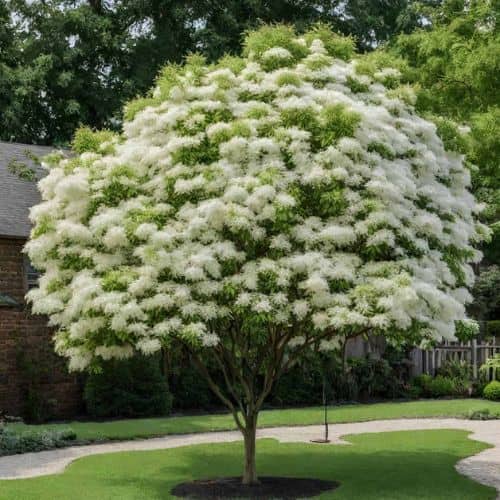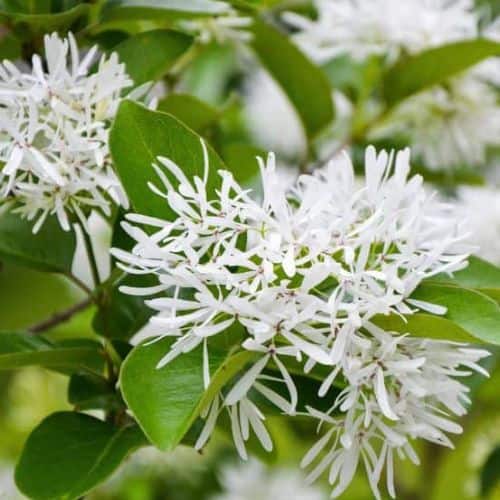The Chinese Fringe Tree, scientifically known as Chionanthus retusus, captivates the eye with its elegant form. Originating from East Asia, this deciduous tree has a moderate growth rate and a rounded, oval crown. Whether standing alone as a focal point or integrated into diverse garden styles, the Chinese Fringe Tree brings sophistication, seasonal vibrancy, and functional benefits to outdoor spaces.

Growing and Caring for Chinese Fringe Trees
These trees do best in well-drained soil, and while they showcase adaptability to various soil types, providing a fertile and loamy substrate enhances their overall health. Plant them in locations that receive full to partial sunlight to ensure optimal conditions for their growth and blooming potential. The moderate growth rate of Chinese Fringe Trees allows for steady development, and their mature height of 15 to 20 feet necessitates adequate spacing during planting to allow for proper air circulation and the full expression of their rounded to oval crown.
In the initial stages of establishment, Chinese Fringe Trees benefit from consistent watering, particularly during dry spells. Mulching around the base of the tree aids in moisture retention, regulates soil temperature, and suppresses weeds. As the tree matures, it requires much less maintenance than during its early years. However, occasional watering during extended dry periods and a balanced fertilizer application in the spring contribute to sustained vitality and vigor.
Pruning is generally minimal and only necessary to shape the tree and remove dead or damaged branches. Their naturally graceful form and arching branches contribute to their aesthetic appeal, and excessive pruning can be avoided to allow the tree to maintain its elegant silhouette. While these trees are relatively hardy, occasional inspections for pests and diseases are advisable. Addressing issues promptly ensures the long-term health and beauty of Chinese Fringe Trees, allowing them to thrive as striking specimens in the garden.
Size and Growth Rate
These trees typically achieve a mature height ranging from 15 to 20 feet. The deliberate growth rate also enhances the density of the foliage, providing ample space for the tree’s distinctive leaves and the breathtaking display of fringe-like flowers. This moderate stature allows Chinese Fringe Trees to be used in various garden settings, from intimate courtyards to larger residential or public spaces.
Branches, Leaves, and Flowers
The branches of Chinese Fringe Trees contribute to their aesthetic allure. During the growing season, they develop a dense network of slender branches that elegantly arch outward. This branching pattern enhances the tree’s overall form and facilitates the display of the exquisite fringe-like flowers that emerge later in the season.
The leaves of the Chinese Fringe Tree are broad, glossy, and dark green, providing a lush backdrop for the tree’s other features. The foliage turns an attractive yellow hue in the fall, adding a splash of seasonal vibrancy to the landscape. The leaves are arranged alternately along the branches, contributing to the tree’s balanced and harmonious appearance. In late spring to early summer, the tree bursts into a profusion of delicate, fringe-like blossoms that drape gracefully from the branches. The flowers, typically white but sometimes tinged with a hint of cream, emit a sweet, subtle fragrance, attracting pollinators like bees and butterflies.

Uses in the Garden
Chinese Fringe trees command attention with their elegant form and captivating flowers when planted as specimen trees. Their moderate size makes them suitable for various garden sizes, from intimate courtyards to expansive estates. The tree’s elegant form and manageable size make it an ideal choice for those seeking a botanical centerpiece without the overwhelming proportions of larger species.
They can also act as shade trees, providing relief during hot summer days. Their dense foliage also contributes to privacy screening, making them ideal for creating natural barriers between different garden areas or shielding outdoor spaces from neighboring views. Furthermore, the vibrant fall foliage adds a seasonal dimension to the garden, ensuring year-round visual interest.
Frequently Asked Questions
When Do Chinese Fringe Trees Bloom?
Chinese Fringe Trees, known as Chionanthus retusus, typically bloom in late spring to early summer. The exact timing of blooming can vary depending on factors such as local climate, weather conditions, and the specific cultivar of the tree. In general, you can expect Chinese fringe trees to start blooming in late May to early June. The blooms are usually white and appear in clusters, creating a stunning display.
Do Chinese Fringe Trees Lose Their Leaves?
Yes, Chinese Fringe Trees are deciduous, meaning they lose their leaves in the fall. In autumn, the leaves will change color, usually turning shades of yellow before dropping from the tree. This is a natural part of the tree’s annual cycle as it prepares for winter dormancy. During winter, the Chinese Fringe Tree will be bare until new leaves emerge in the spring.
How Fast Does A Chinese Fringe Tree Grow?
Chinese Fringe Trees are considered to have a moderate growth rate. When young and provided with adequate growing conditions, these trees can typically grow between 12 to 24 inches (30 to 61 centimeters) per year. However, growth rates may slow down as the tree matures. However, growth rates can be influenced by factors such as soil fertility, moisture levels, sunlight exposure, and pruning practices.
